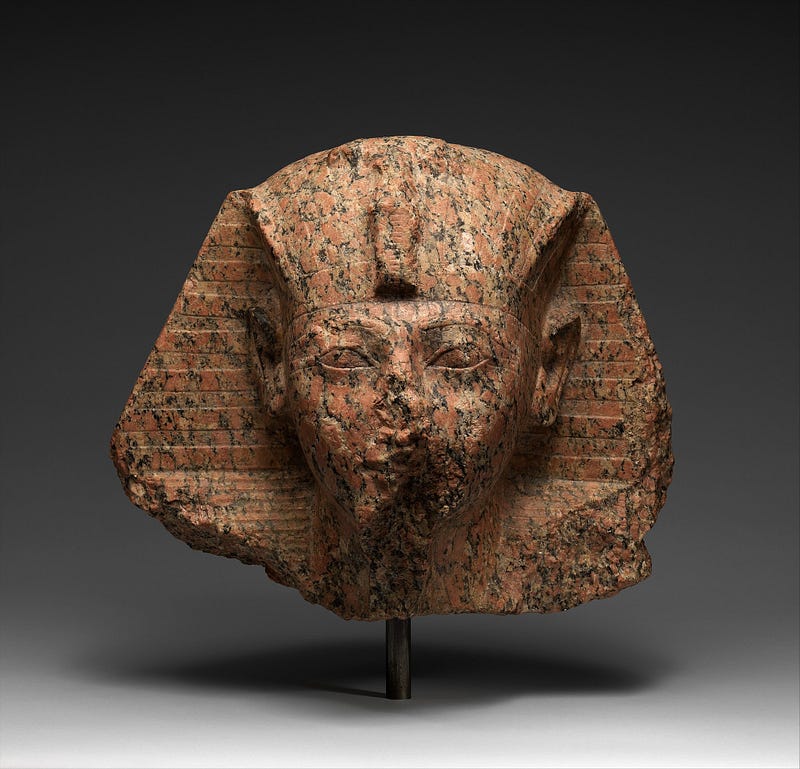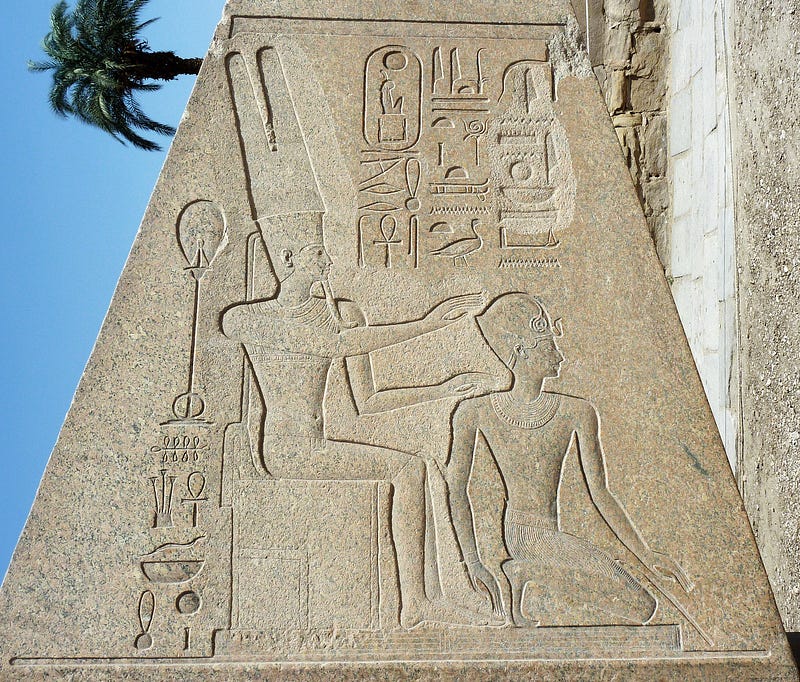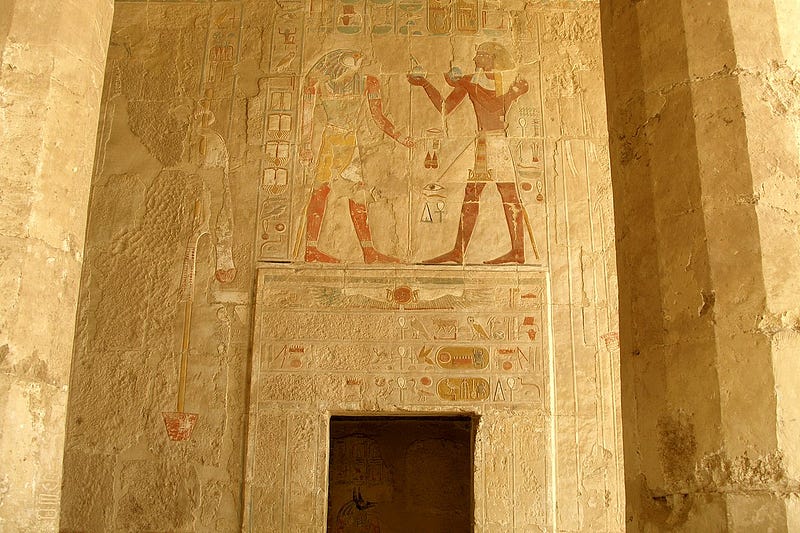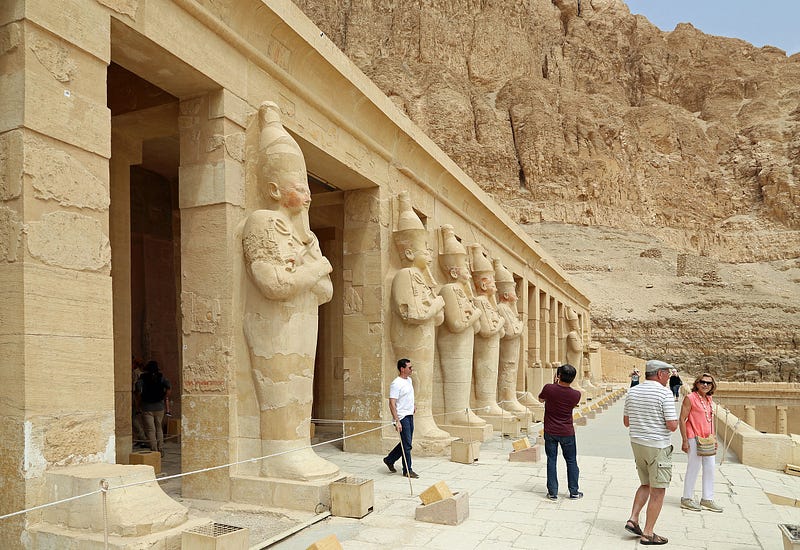Queen Hatshepsut: The Most Renowned Pharaohess of Ancient Egypt
Written on
Queen Hatshepsut ascended to power in an unexpected manner and ruled for 21 years. Despite the societal norms that deemed a woman's place unfit for the throne, she was adored by her people. What led to her adoration in ancient Egypt, and why did history seem to forget her?

Hatshepsut remains a mysterious figure. Even during her reign, she was independent, and her secrets persisted even after her passing. While her time as queen is often characterized as peaceful, she was, in fact, a trailblazer. Not only did she occupy the pharaoh's throne—a position usually held by men—but she also intended to pass the crown to her daughter, Neferura.
Details about Hatshepsut's life are sparse. Following her death, her statues were defaced, and her name and likeness were erased from historical records. The precise dates of her birth and death remain a mystery. Had it not been for the meticulous research of Champollion and Lepsius, we might not have known about this extraordinary leader. Although she lived during the 15th century BC, knowledge of her existence resurfaced only 3,300 years later.
How do we know about Hatshepsut? The Deir el-Bahari valley, part of the Theban necropolis on the Nile's west bank, houses Hatshepsut's temple. French Egyptologist Jean-Francois Champollion first reached this site in the early 19th century. He had previously deciphered ancient hieroglyphs and discovered cartouches of two rulers on the temple walls.
One belonged to the known pharaoh Thutmose III, but the other, Hatshepsut, was a complete surprise. Neither Champollion nor his contemporaries had heard of her. The placement of Hatshepsut's figure prominently before Thutmose and the feminine references used to describe her raised many questions, which Champollion was unable to answer.
It took over a decade for Karl Richard Lepsius to position Hatshepsut among the pharaohs, paving the way for further exploration of her temple, led by Auguste Mariette and later Edouard Naville in the 1890s.
In 1903, British archaeologist Howard Carter, later famous for discovering Tutankhamun's tomb, stumbled upon Hatshepsut’s tomb in the Valley of the Kings, designated KV 20. Regrettably, many of her memorial items, including her mummy, were lost. This initiated a lengthy effort to piece together her enigmatic legacy and that of her daughter.

The Royal Daughter and Marriage to Her Half-Brother Hatshepsut, known as "the first of dignified women," was born around 1500 BC into a royal family in Thebes. Her father, Pharaoh Thutmose I, had no male heirs with his principal wife, Queen Ahmose, which set the stage for her ascent. Thutmose I's secondary wife, Mutnofret, bore a son, Thutmose II, who ultimately claimed the throne.
To secure his position, Thutmose II married Hatshepsut, his half-sister, ensuring his claim to the throne through her royal lineage. At the time, while incest within the royal family was not uncommon, it was believed that Hatshepsut's parents may have been siblings. Hatshepsut soon gave birth to a daughter, Neferura.
History tends to repeat itself; Hatshepsut did not produce a son for Thutmose II, who instead had a child with his second wife, Isis. Upon Thutmose II's untimely death, his son with Isis, Thutmose III, rose to power. To validate his claim, a miracle was staged during a ceremony at the Temple of Amun, proclaiming him king. Given Thutmose III's youth at the time, Hatshepsut served as regent.

Queen Hatshepsut Becomes Pharaoh As regent, the young widow retained her titles: Spouse of the King, Sister of the King, and Spouse of God. Perhaps influenced by those around her, she began to entertain the notion of ruling independently. Ultimately, she declared herself king in the seventh year of Thutmose III's reign, adopting the throne name Maatkara and the full regalia of a pharaoh. Thus, ancient Egypt was governed by two co-regents, though Hatshepsut's prominence was undeniable.
Though the years were counted from Thutmose III's accession, Hatshepsut's portrayal in artwork indicated her dominance in this unusual partnership.
A Woman on a Male Throne: Hatshepsut's Path to Power Traditionally, a pharaoh was male. The role of a queen was typically as a supportive figure. If a woman ever ascended to the throne, she usually adopted male titles and was represented as a man. Hatshepsut, however, openly embraced her femininity, proclaiming herself "Daughter of Ra" and "Perfect Goddess." She presented herself as a feminine incarnation of Horus, though she refrained from using the title "Mighty Bull," which was explicitly masculine.
Her early reign's imagery blended feminine characteristics with traditional pharaonic power. Neferura, her daughter, played the role of Spouse of God, depicted alongside Hatshepsut in temples.
Initially, Neferura remained largely in the background, but as her mother took the throne, she began to gain visibility. Hatshepsut conferred upon her daughter the title of Divine Spouse of Amun, indicating her preparation for future rulership.
Despite her achievements, Hatshepsut felt insecure due to Thutmose III's legitimate claim to the throne. Over time, she began to represent herself as a male pharaoh, asserting that she had been co-regent during her father's life. To further solidify her legitimacy, she promoted a narrative of divine birth, claiming Amun-Ra himself was her father, conceived by her mother, Ahmose.
This divine narrative was bolstered by temple depictions illustrating Amun's union with Ahmose and Hatshepsut being born as a boy.
The average Egyptian likely accepted her story without question, as the pharaoh was seen as the guarantor of harmony and order, regardless of gender.
Hatshepsut was adept in navigating the political landscape, surrounding herself with capable officials and recognizing the importance of her public image. It was noted that "her fragrance is like the fragrance of a god," with a vial of perfume attributed to her surviving to this day.

Discoveries from Hatshepsut's Temple: The Enigma of Neferura The main sanctuary of the god Amun revealed Hatshepsut’s secrets. This area was reserved for the kingdom's elite and contained a depiction of Hatshepsut's mother, Ahmose. Research indicated that Neferura had previously been represented there, but her image was altered. Initially portrayed with a princess's diadem, it was later replaced with a queen's headdress, indicating her priestly role.
In Hatshepsut's 11th year on the throne, Neferura's figure was replaced with that of her mother.

Remarkable Facts: Hatshepsut's Legacy Hatshepsut ruled for 21 years, prioritizing economic growth over warfare. In her 9th year, she organized an expedition to the land of Punt (modern-day Sudan), returning with gold, incense, precious woods, and exotic animals. Her architectural contributions included numerous temples, such as those at Karnak and Medinet Habu, and her most significant work, the "Temple of the Millions of Years" at Deir el-Bahari, serving as both a burial site and a temple dedicated to Amun-Ra.
Hatshepsut's Death and the Mystery of Her Erasure Hatshepsut was interred in tomb KV 20 in the Valley of the Kings alongside her father, Thutmose I. Following her death, Thutmose III fully assumed power and enjoyed the support of Hatshepsut's dedicated officials. Remarkably, she managed to exert influence over such a strong figure as Thutmose III during her reign. However, two decades after her passing, Thutmose III ordered a campaign to erase her memory, removing her images and names from monuments.
For ancient Egyptians, the pharaoh embodied divinity and order. The reasons behind Hatshepsut's rise and subsequent erasure from history remain unclear, as do the theological implications of her reign.

Discovery and Controversy Surrounding Hatshepsut's Mummy Thutmose III's successor sought to obscure Hatshepsut's legacy, even hiding evidence of her mummy. In 2007, a mummy discovered in 1903 was suggested to be hers. Zahi Hawass, then head of Egypt's Supreme Council of Antiquities, claimed it was indeed Hatshepsut's. This mummy was found alongside that of Sitra, buried in a wooden coffin within tomb KV 60.
The theory posits that Hatshepsut's remains were moved to safeguard them from desecration following Thutmose III's actions. DNA testing later confirmed a familial link to Ahmose-Nefertari, Hatshepsut's great-grandmother. Additional evidence supporting her royal lineage included the mummy's characteristic pose and missing molar tooth.
However, the identification of the mummy remains contentious. Questions linger regarding the origins of the missing tooth and the broader implications of her family connections, given the number of royal women in the Valley of the Kings. Furthermore, the physical appearance of Hatshepsut as depicted in art contrasts with the characteristics of the mummy, leading to further uncertainty about her life.
In conclusion, while Hatshepsut's reign and legacy are well-documented, many questions continue to surround her life, death, and the subsequent erasure of her memory.